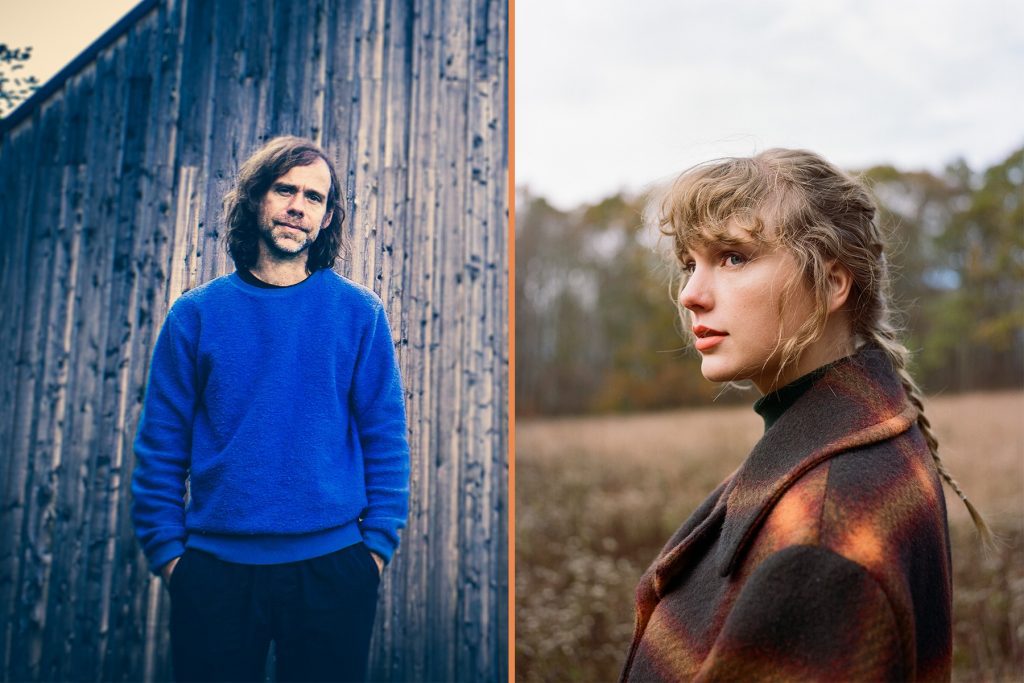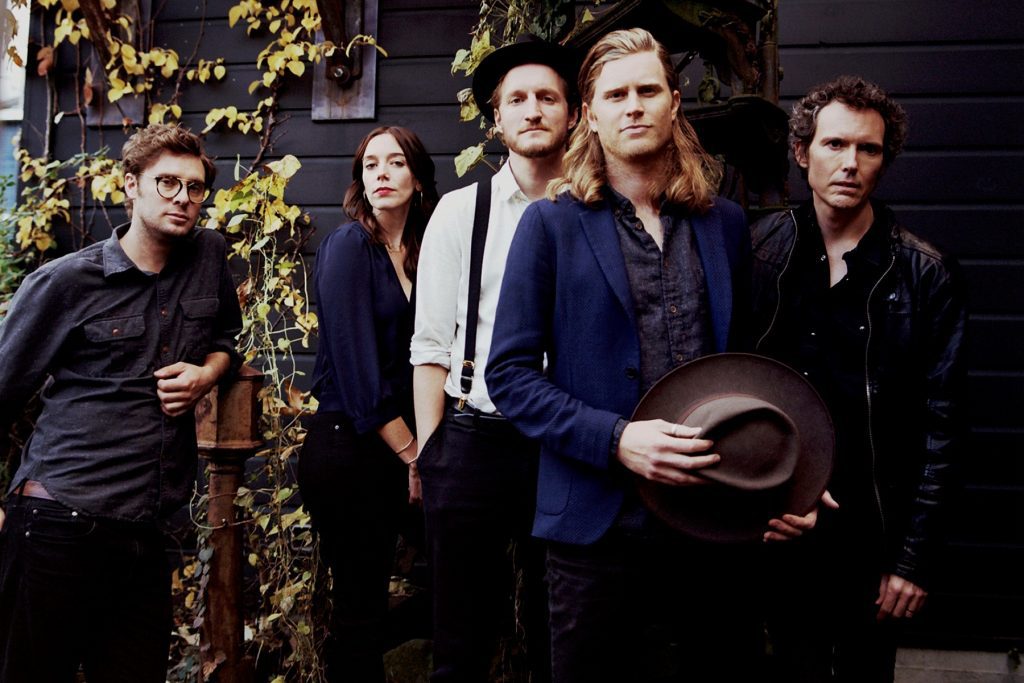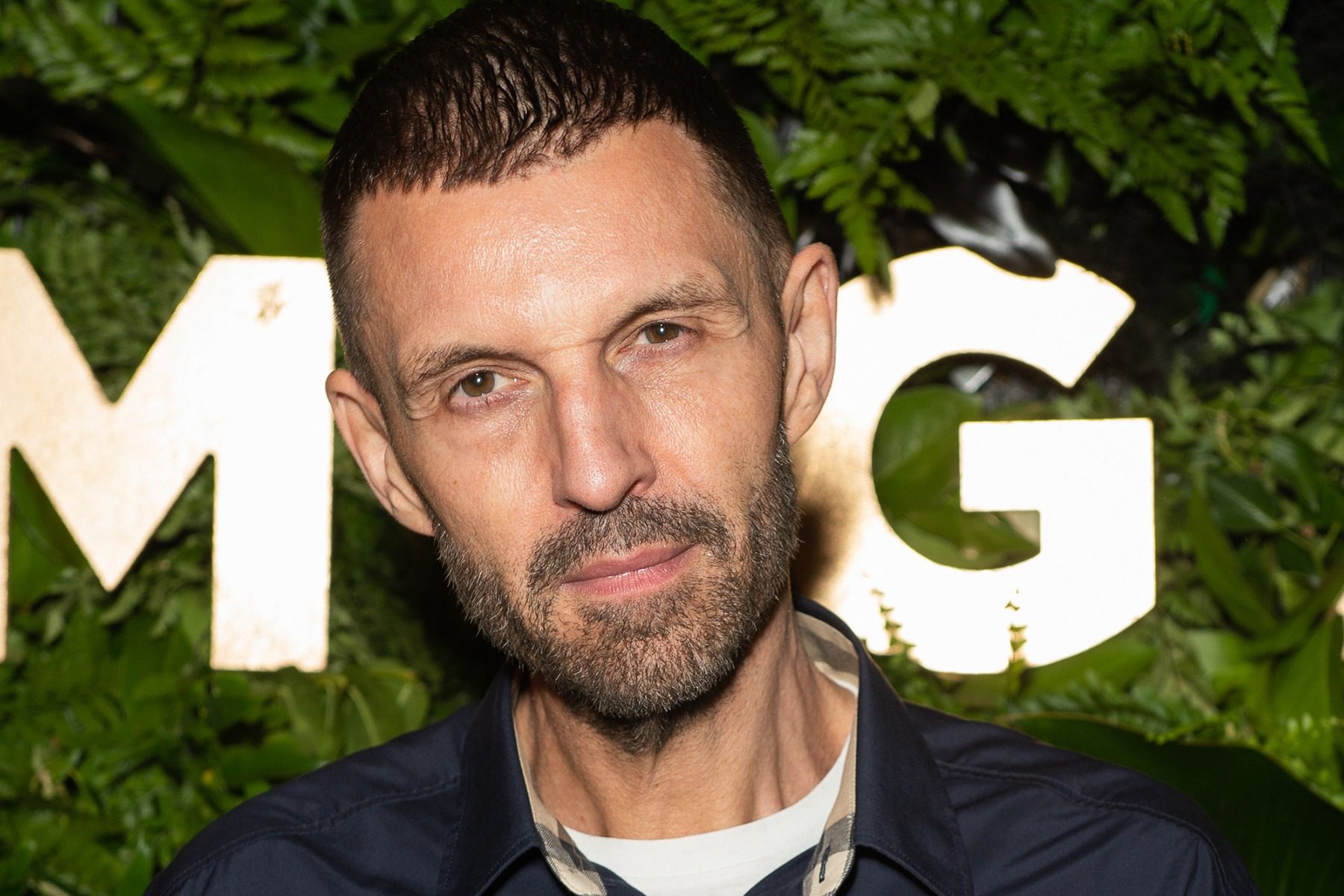
Aaron Dessner on How His Collaborative Chemistry With Taylor Swift Led to ‘Evermore’
Taylor Swift and Aaron Dessner didn’t expect to make another record so soon after Folklore. As they were putting the final touches on Swift’s album this past summer, the two artists had been collaborating remotely on possible songs for Big Red Machine, Dessner’s music project with Justin Vernon of Bon Iver (who also dueted with Swift on the Folklore track “Exile”).
“I think I’d written around 30 of those instrumentals in total,” Dessner recalls. “So when I started sharing them with Taylor over the months that we were working on Folklore, she got really into it, and she wrote two songs to some of that music.”
One was “Closure,” an experimental electronic track in 5/4 time signature that was built over a staccato drum kit. The other song was “Dorothea,” a rollicking, Americana piano tune. The more Dessner listened to them, the more he realized that they were continuations of Folklore‘s characters and stories. But the real turning point came soon after Folklore‘s surprise release in late July, when Dessner wrote a musical sketch and named it “Westerly,” after the town in Rhode Island where Swift owns the house previously occupied by Rebekah Harkness.
blogherads.adq.push(function () {
blogherads
.defineSlot( ‘medrec’, ‘gpt-dsk-tab-article-inbody1-uid0’ )
.setTargeting( ‘pos’, [“mid-article”,”mid”,”in-article1″,”mid-article1″] )
.setSubAdUnitPath(“music//article//inbody1”)
.addSize([[300,250],[620,350],[2,2],[3,3],[2,4],[4,2]])
;
});
“I didn’t really think she would write something to it — sometimes I’ll name songs after my friends’ hometowns or their babies, just because I write a lot of music and you have to call it something, and then I’ll send it to them,” Dessner says. “But, anyway, I sent it to her, and not long after she wrote ‘Willow’ to that song and sent it back.”
It was a moment not unlike when Swift first sent him the song “Cardigan” back in the spring, where both she and Dessner felt an instant creative spark — and then just kept writing. Before long, they were creating even more songs with Vernon, Jack Antonoff, Dessner’s brother Bryce, and “William Bowery” (the pseudonym of Swift’s boyfriend Joe Alwyn) for what would eventually lead to Folklore‘s wintry sister record, Evermore.
Even more spontaneous than the album that preceded it, Evermore features more eclectic production alongside Swift’s continued project of character-driven songwriting, and includes an even wider group of collaborators, like Haim and Dessner’s own band the National. Dessner spoke to IndieLand about the album’s experimentation, how it was recorded during the making of the doc The Long Pond Studio Sessions, and how he sees his collaboration with Swift continuing in the future.
When did you realize this was going to end up being another album?
It was after we’d written several [songs], seven or eight or nine. Each one would happen, and we would both be in this sort of disbelief of this weird alchemy that we had unleashed. The ideas were coming fast and furiously and were just as compelling as anything on Folklore, and it felt like the most natural thing in the world. At some point, Taylor wrote “Evermore” with William Bowery, and then we sent it to Justin, who wrote the bridge, and all of a sudden, that’s when it started to become clear that there was a sister record. Historically, there are examples of this, of records which came in close succession that I love — certain Dylan records, Kid A and Amnesiac. I secretly fell in love with the idea that this was part of the same current, and that these were two manifestations that were interrelated. And with Taylor, I think it just became clear to her what was happening. It really picked up steam, and at some point, there were 17 songs — because there are two bonus tracks, which I love just as much.
blogherads.adq.push(function () {
blogherads
.defineSlot( ‘medrec’, ‘gpt-dsk-tab-article-inbody2-uid1’ )
.setTargeting( ‘pos’, [“mid-article2″,”mid”,”in-article2″,”mid-article”] )
.setSubAdUnitPath(“music//article//inbody2”)
.addSize([[300,250],[300,251],[620,350],[2,4],[4,2],[3,3]])
;
});
Evermore definitely sounds more experimental than Folklore, and has more variety — you have these electronic songs that sound like Bon Iver or Big Red Machine, but you also have the closest thing Taylor has written to country songs in the last decade. Was there a conscious effort on her part to branch out more with this album?
Sonically, the ideas were coming from me more. But I remember when I wrote the piano track to “Tolerate It,” right before I sent it to her, I thought, This song is intense. It’s in 10/8, which is an odd time signature. And I did think for a second, “Maybe I shouldn’t send it to her, she won’t be into it.” But I sent it to her, and it conjured a scene in her mind, and she wrote this crushingly beautiful song to it and sent it back. I think I cried when I first heard it. But it just felt like the most natural thing, you know? There weren’t limitations to the process. And in these places where we were pushing into more experimental sounds or odd time signatures, that just felt like part of the work.
It was really impressive to me that she could tell these stories as easily in something like “Closure” as she could in a country song like “Cowboy Like Me.” Obviously, “Cowboy Like Me” is much more familiar, musically. But to me, she’s just as sharp and just as masterful in her craft in either of those situations. And also, just in terms of what we were interested in, there is a wintry nostalgia to a lot of the music that was intentional on my part. I was leaning into the idea that this was fall and winter, and she’s talked about that as well, that Folklore feels like spring and summer to her and Evermore is fall and winter. So that’s why you hear sleigh bells on “Ivy,” or why some of the imagery in the songs is wintery.
I can hear that in the guitar on “‘Tis the Damn Season,” too. It almost sounds like the National with that very icy guitar line.
I mean, that is literally like, me in my most natural state. [laughs] If you hand me a guitar, that’s what it sounds like when I start playing it. People associate that sound with the National, but that’s just because I finger-pick an electric guitar like that a lot — if you solo the guitar on “Mr. November,” it’s not unlike that.
blogherads.adq.push(function () {
blogherads
.defineSlot( ‘medrec’, ‘gpt-dsk-tab-inbodyX-uid2’ )
.setTargeting( ‘pos’, [“mid”,”mid-articleX”,”in-articleX”,”mid-article”] )
.setSubAdUnitPath(“music//article//inbodyX”)
.addSize([[300,250],[300,251],[3,3],[620,350]])
.setLazyLoadMultiplier(2)
;
});
That song, to me, has always felt nostalgic or like some sort of longing. And the song that Taylor wrote is so instantly relatable, you know, “There’s an ache in you put there by the ache in me.” I remember when she sang that to me in my kitchen — she had written it overnight during The Long Pond Studio Sessions, actually.
Did she record all her Evermore vocals at Long Pond while you were filming the Studio Sessions documentary?
Not all of them, but most of them. She stayed after we were done filming and then we recorded a lot. It was crazy because we were getting ready to make that film, but at the same time, these songs were accumulating. And so we thought, “Hmm, I guess we should just stay and work.”
On “Closure,” there are parts where Taylor’s vocals are filtered through the Messina, which is this vocal modifier that Justin Vernon uses a lot in his work with Bon Iver. How were you able to modify her vocals with it, if she was never in the same room as Justin?
I went to see Justin at one point — that’s the one trip I’ve made — and we worked together at his place on stuff. He plays the drums on “Cowboy Like Me” and “Closure,” and he plays guitar and banjo and sings on “Ivy,” and sings on “Marjorie” and “Evermore.” And then we processed Taylor’s vocals through his Messina chain together. He was really deeply involved in this record, even more so than the last record. He’s always been such a huge help to me, and not just by getting him to play stuff or sing stuff — I can also send him things and get his feedback. We’ve done a ton of work together, but we have different perspectives and different harmonic brains. He obviously has his own studio set up at home, but it was nice to be able to see him and work on this stuff.
“No Body, No Crime” is also really interesting, just because I don’t think I’ve ever heard you produce a song like that. How did this country murder ballad featuring Haim end up on the record?
Taylor wrote that one alone and sent me a voice memo of her playing guitar — she wrote it on this rubber-bridge guitar that I got for her. It’s the same kind I play on “Invisible String.” So she wrote “No Body, No Crime” and sent me a voice memo of it, and then I started building on that. It’s funny, because the music I’ve listened to the most in my life are things that are more like that — roots music, folk music, country music, old-school rock & roll, the Grateful Dead. It’s not really the sound of the National or other things I’ve done, but it feels like a warm blanket.
blogherads.adq.push(function () {
blogherads
.defineSlot( ‘medrec’, ‘gpt-dsk-tab-inbodyX-uid3’ )
.setTargeting( ‘pos’, [“mid”,”mid-articleX”,”in-articleX”,”mid-article”] )
.setSubAdUnitPath(“music//article//inbodyX”)
.addSize([[300,250],[300,251],[3,3],[620,350]])
.setLazyLoadMultiplier(2)
;
});
That song also had a lot of my friends on it — Josh Kaufman, who played harmonica on “Betty,” also plays harmonica on this one and some guitar. JT Bates plays the drums on that song — he’s an amazing jazz guitarist, but he also has an incredible feel [for rhythm] when it comes to a song like that. He also played the drums on “Dorothea.” And then Taylor had specific ideas from the beginning about references and how she wanted it to feel, and that she wanted the Haim sisters to sing on it. We had them record the song with Ariel Reichshaid, they sent that from L.A., and then we put it together when Taylor was here [at Long Pond]. They’re an incredible band, and it was another situation where we were like, “Well, this happened.” It felt like this weird little rock & roll history anecdote.
You also brought on the National to record “Coney Island.” What was that process like, where you’re recording a song with your band that’s for a different artist?
I had been working on a bunch of music with my brother [Bryce Dessner], some of which we were sending to Taylor also. At that stage, “Coney Island” was all the music except the drums. And as I was writing it, I don’t think I was ever thinking, “This sounds like the National or this sounds like Big Red Machine or this sounds like something totally different.” But Taylor and William Bowery wrote this incredible song, and we first recorded it with just her vocals. It has this really beautiful arc to the story, and I think it’s one of the strongest, lyrically and musically. But listening to the words, we all collectively realized that this does feel like the most related to the National — it almost feels like a story Matt [Berninger] might tell, or I could hear Bryan [Devendorf] playing the drum part.
So we started talking about how it would be cool to get the band, and I called Matt and he was excited for it. We got Bryan to play drums and we got Scott [Devendorf] to play bass and a pocket piano, and Bryce helped produce it. It’s weird, because it does really feel like Taylor, obviously, since she and William Bowery wrote all the words, but it also feels like a National song in a good way. I love how Matt and Taylor sound together. And it was nice because we haven’t played a show in a year, and I don’t know when we will again. You kind of lose track of each other, so in a way, it was nice to reconnect.
blogherads.adq.push(function () {
blogherads
.defineSlot( ‘medrec’, ‘gpt-dsk-tab-inbodyX-uid4’ )
.setTargeting( ‘pos’, [“mid”,”mid-articleX”,”in-articleX”,”mid-article”] )
.setSubAdUnitPath(“music//article//inbodyX”)
.addSize([[300,250],[300,251],[3,3],[620,350]])
.setLazyLoadMultiplier(2)
;
});
When working on Folklore, you had to keep most of your collaborators in the dark about who you were working with. What was the process like this time around, now that everyone knew it was Taylor? How did you keep it a secret?
It was hard. We had to be secretive because of how much people are consuming every shred of information they can find about her, and that’s been an oppressive reality she’s had to deal with. But the fact that no one in the public knew allowed for more freedom of enjoying the process. A lot of the same musicians that played on Folklore played on Evermore. Again, it was a situation where I didn’t tell them what it was, and they couldn’t hear her vocals, but I think a lot of them assumed, especially because of the level of secrecy. [laughs] But as funny as this is, I think everyone who’s been involved has been grateful for these records to play on this year and is proud of them. It kind of just doesn’t happen, to make two great records in such a short period of time. Everyone’s a little bit like, “How did this happen?” and nobody takes it for granted.
Taylor has mentioned that you recorded “Happiness” just a week before the album was released. Was that something you guys wrote, recorded, and produced all at the last minute, or was it something you’d been sitting on for a while before you finally cracked the code?
There were two songs like that. One is a bonus track called “Right Where You Left Me,” and the other one was “Happiness,” which she wrote literally days before we were supposed to master. That’s similar to what happened with Folklore, with “The 1” and “Hoax,” which she wrote days before. We mixed all the tracks here, and it’s a lot to mix 17 songs, it’s like a Herculean task. And it was funny, because I walked into the studio and Jon Low, our engineer here, was mixing and had been working the whole time toward this. And I came in and he’s in the middle of mixing and I was like, “There are two more songs.” And he looked at me like, “…We’re not gonna make it.” Because it does take a lot of time to work out how to finish them.
But she sang those remotely. And the music for “Happiness” is something that I had been working on since last year. I had sang a little bit on it, too — I thought it was a Big Red Machine song, but then she loved the instrumental and ended up writing to it. Same with the other one, “Right Where You Left Me” — it was something I had written right before I went to visit Justin, because I thought, “Maybe we’ll make something when we’re together there.” And Taylor had heard that and wrote this amazing song to it. That is a little bit how she works — she writes a lot of songs, and then at the very end she sometimes writes one or two more, and they often are important ones.
blogherads.adq.push(function () {
blogherads
.defineSlot( ‘medrec’, ‘gpt-dsk-tab-inbodyX-uid5’ )
.setTargeting( ‘pos’, [“mid”,”mid-articleX”,”in-articleX”,”mid-article”] )
.setSubAdUnitPath(“music//article//inbodyX”)
.addSize([[300,250],[300,251],[3,3],[620,350]])
.setLazyLoadMultiplier(2)
;
});
My favorite song on the album is “Marjorie,” and I feel like, for most artists, the instinct would be to present a song like that as a somber piano ballad. But “Marjorie” has this lively electronic beat that runs through it — it literally sounds alive. How did you come up with that?
It’s interesting, because with “Marjorie,” that’s a track that actually existed for a while, and you can hear elements of it behind the song “Peace.” This weird drone that you hear on “Peace,” if you pay attention to the bridge of “Marjorie,” you’ll hear a little bit of that in the distance. Some of what you hear is from my friend Jason Treuting playing percussion, playing these chord sticks, that he actually made for a piece that my brother wrote called “Music for Wooden Strings.” They’re playing these chord sticks, and you can hear those same chord sticks on the National song “Quiet Light.”
I collect a lot of rhythmic elements like that, and all kinds of other sounds, and I give them to my friend Ryan Olson, who’s a producer from Minnesota and has been developing this crazy software called Allovers Hi-Hat Generator. It can take sounds, any sounds, and split them into identifiable sound samples, and then regenerate them in randomized patterns that are weirdly very musical. There’s a lot of new Big Red Machine songs that use those elements. But I’ll go through it and find little parts that I like and loop them. That’s how I made the backing rhythm of “Marjorie.” Then I wrote a song to it, and Taylor wrote to that. In a weird way, it’s one of the most experimental songs on the album — it doesn’t sound that way, but when you pick apart the layers underneath it, it’s pretty interesting.
I do have to ask: How did you come to find out about William Bowery’s real identity as Joe Alwyn? Or did you know all along?
I guess I can say now that I’ve sort of known all along — I was just being careful. Although we never really explicitly talked about it. But I do think it’s been really special to see a number of songs on these albums that they wrote together. William plays the piano on “Evermore,” actually. We recorded that remotely. That was really important to me and to them, to do that, because he also wrote the piano part of “Exile,” but on the record, it’s me playing it because we couldn’t record him easily. But this time, we could. I just think it’s an important and special part of the story.
blogherads.adq.push(function () {
blogherads
.defineSlot( ‘medrec’, ‘gpt-dsk-tab-inbodyX-uid6’ )
.setTargeting( ‘pos’, [“mid”,”mid-articleX”,”in-articleX”,”mid-article”] )
.setSubAdUnitPath(“music//article//inbodyX”)
.addSize([[300,250],[300,251],[3,3],[620,350]])
.setLazyLoadMultiplier(2)
;
});
Do you have a personal favorite song or a moment that you’re proudest of?
“‘Tis the Damn Season” is a really special song to me for a number of reasons. When I wrote the music to it, which was a long time ago, I remember thinking that this is one of my favorite things I’ve ever made, even though it’s an incredibly simple musical sketch. But it has this arc to it, and there’s this simplicity in the minimalism of it and the kind of drum programming in there, and I always loved the tone of that guitar. When Taylor played the track and sang it to me in my kitchen, that was a highlight of this whole time. That track felt like something I have always loved and could have just stayed music, but instead, someone of her incredible storytelling ability and musical ability took it and made something much greater. And it’s something that we can all relate to. It was a really special moment, not unlike how it felt when she wrote “Peace,” but even more so.
Do you see this collaboration with Taylor continuing onward, to more albums or Big Red Machine projects?
It’s kind of the thing where I have so many musicians in my life that I’ve grown close to, and make things with, and are just part of my life. And I’ve rarely had this kind of chemistry with anyone in my life — to be able to write together, to make so many beautiful songs together in such a short period of time. Inevitably, I think we will continue to be in each other’s artistic and personal lives. I don’t know exactly what the next form that will take, but certainly, it will continue.
I do think this story, this era, has concluded, and I think in such a beautiful way with these sister records — it does kind of feel like there’s closure to that. But she’s definitely been very helpful and engaged with Big Red Machine, and just in general. She feels like another incredible musician that I’ve gotten to know and am lucky to have in my life. It’s this whole community that moves forward and takes risks and, hopefully, there will be other records that appear in the future.




